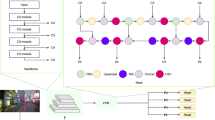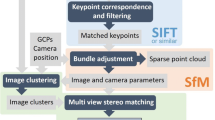Abstract
A difficult problem in forestry is tree inventory. In this study, a GoProHero attached to a small unmanned aerial vehicle was used to capture images of a small area covered by pinus pinea trees. Then, a digital surface model was generated with image matching. The elevation model representing the terrain surface, a ‘digital terrain model’, was extracted from the digital surface model using morphological filtering. Individual trees were extracted by analyzing elevation flow on the digital elevation model because the elevation reached the highest value on the tree peaks compared to the neighborhood elevation pixels. The quality of the results was assessed by comparison with reference data for correctness of the estimated number of trees. The tree heights were calculated and evaluated with ground truth dataset. The results showed 80% correctness and 90% completeness.

Source: maps.google.com













Similar content being viewed by others
References
Baletti C, Guerra F, Tsioukas V, Vernier P (2014) Calibration of action cameras for photogrammetric purposes. Sensors 14(9):17471–17490
Bertram TT, Bock TT, Bulgakov AG, Evgenov AA (2014) Generation the 3D model building by using the quadcopter. In: Proceedings of the 31st ISARC, Sydney, p 6
Culvenor DS (2002) TIDA: an algorithm for the delineation of tree crowns in high spatial resolution remotely sensed imagery. Comput Geosci 28(1):33–44
Díaz-Varela RA, de la Rosa R, León L, Zarco-Tejada PJ (2015) High-resolution airborne UAV imagery to assess olive tree crown parameters using 3D photo reconstruction: application in breeding trials. Remote Sens 7:4213–4232
Erikson M (2004) Species classification of individually segmented tree crowns in high-resolution aerial images using radiometric and morphologic image measures. Remote Sens Environ 91(3–4):469–477
Feng QL, Liu JT, Gong JH (2015) UAV remote sensing for urban vegetation mapping using random forest and texture analysis. Remote Sens 7:1074–1094
Fritz A, Kattenborn T, Koch B (2013) Uav-based photogrammetric point clouds—tree STEM mapping in open stands in comparison to terrestrial laser scanner point clouds. ISPRS Arch 41(W2):141–146
Gatziolis D, Lienard JF, Vogs A, Strigul NS (2015) 3D tree dimensionality assessment using photogrammetry and small unmanned aerial vehicles. PLoS ONE 10(9):1–21
Hirschmugl M, Ofner M, Raggam J, Schardt M (2007) Single tree detection in very high-resolution remote sensing data. Remote Sens Environ 110:533–544
Ioannis Z, Gitas GH, Mitri GV (2004) Object-based image classification for burned area mapping of Creus Cape, Spain, using NOAA-AVHRR imagery. Remote Sens Environ 92(3):409–413
Kattenborn T, Sperlich M, Bataua K, Koch B (2014) Automatic single tree detection in plantations using UAV-based photogrammetric point clouds. ISPRS Arch 43:139–144
Leckie DG, Gougeon FA, Walsworth N, Paradine D (2003) Stand delineation and composition estimation using semi-automated individual tree crown analysis. Remote Sens Environ 3:355–369
Lin Y, Jiang M, Yao YJ, Zhang LF, Lin JY (2015) Use of UAV oblique imaging for the detection of individual trees in residential environments. Urban For Urban Green 14(2):404–412
Lisein J, Pierrot-Deseilligny M, Bonnet S, Lejeune P (2013) A photogrammetric workflow for the creation of a forest canopy height model from small unmanned aerial system imagery. Forests 4:922–944
Paris C, Bruzzone L (2015) A three-dimensional model-based approach to the estimation of the tree top height by fusing low-density lidar data and very high resolution optical images. IEEE Trans Geosci Remote Sens 53(1):467–480
Pateraki M (2005) Adaptive multi-image matching for DSM generation from airborne linear array CCD data. Ph. D. dissertation, No. 86, Institute of Geodesy and Photogrammetry, ETH Zurich, p 170
Pouliot DA, King DJ, Bell FW, Pitt DG (2002) Automated tree crown detection and delineation in high-resolution digital camera imagery of coniferous forest regeneration. Remote Sens Environ 82(2–3):322–334
Roth AF (1983) Thinning pine stands for top returns. ANR-96. http://goo.gl/cHMwC4. Accessed on 04 April 2016
Suarez JC, Ontiveros C, Smith S, Snape S (2005) Use of airborne LiDAR and aerial photography in the estimation of individual tree heights in forestry. Remote Sens Environ 31:253–262
Torres-Sánchez J, López-Granados F, Serrano N, Arquero O, Peña JM (2015) High-throughput 3-D monitoring of agricultural-tree plantations with unmanned aerial vehicle (UAV) technology. PLoS ONE 10(6):1–20
Wallis KF (1976) Seasonal adjustment and relations between variables. J Am Stat Assoc 69(345):18–31
Zhang L, Gruen A (2004) Automatic DSM generation from linear array imagery data. ISPRS Arch 35(3):128–133
Zhang KQ, Chen SC, Whitman D, Shyu ML, Yan JH, Zhang CC (2003) A progressive morphological filter for removing non-ground measurements from airborne LIDAR data. IEEE Trans Geosci Remote Sens 41:872–882
Acknowledgements
The author acknowledges the support of Dr. Halil İbrahim YOLCU for controlling the UAV system, student Batuhan GÜLLÜDERE, and lecturers Tevfik Fikret HORZUM, Ercüment AKSOY, and their student team for their help during the fieldwork.
Author information
Authors and Affiliations
Corresponding author
Additional information
Project funding: The research for this paper was financially supported by the scientific research projects coordination unit of Akdeniz University, Project No. FBA-2015-446.
The online version is available at http://www.springerlink.com.
Corresponding editor: Tao Xu.
Rights and permissions
About this article
Cite this article
Demir, N. Using UAVs for detection of trees from digital surface models. J. For. Res. 29, 813–821 (2018). https://doi.org/10.1007/s11676-017-0473-9
Received:
Accepted:
Published:
Issue Date:
DOI: https://doi.org/10.1007/s11676-017-0473-9




